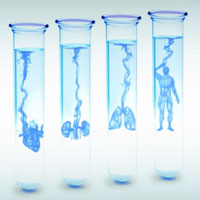COVID-19 and Scarce Hospital Resources:
B·R·A·H·M·S MR-proADM for Risk Stratification to Support Decisions on the Required Level of Care

MR-proADM on presentation to the ED
- Test MR-proADM as an aid to
- and decide on safe discharge or hospital admission
- <0.87 nmol/L
→ low risk for progression to a more severe disease condition, i.e. safe discharge possible Ref-1 - >0.87 nmol/L
→ elevated risk for progression to a more severe disease condition, hospital admission recommended Ref‑1
MR-proADM during ICU stay
- Test MR-proADM as an aid to
- <2.25 nmol/L
→ safe discharge of clinically stable patients from the ICU to a lower level of care possible Ref-2
MR-proADM as an aid to support decision on patient disposition
The biomarker mid-regional proadrenomedullin (MR-proADM) allows an easier and more accurate risk assessment in pneumonia patients compared to standard clinical scores (e.g. SOFA), Ref-3-4 independent of etiology, i.e. viral, bacterial or combined infection. Ref-5 Thus, MR-proADM testing is a useful tool to improve early detection of organ dysfunction and progression to sepsis and septic shock. Ref-2 In conjunction with clinical evaluation and other laboratory findings, MR-proADM can be used as an aid to support decision on patient disposition. Ref-1
A recent analysis of 1099 COVID-19 patient data sets from a range of medical centers in China showed more than 90% of patients presenting in the ED with symptoms of viral pneumonia. In almost all patients death was associated with progression to sepsis/septic shock and respiratory failure/ Acute Respiratory Distress Syndrome (ARDS). Radiologic findings and clinical symptoms on admission did not correlate to severity or outcome risk. Ref-6
Although helpful to identify those COVID-19 patients with a poor prognosis, Ref-7 risk scores like CRB-65 and qSOFA include too many false-positive patients, thereby possibly creating a higher than needed demand for scarce hospital resources. PSI, SOFA and APACHE scores are more accurate, but also more complex to perform.
MR-proADM is an easy to perform biomarker assay. It has been demonstrated to be more accurate compared to any of these scores if used alone, and to improve these scores if used in combination.Ref-3-4
Integration of MR-proADM into clinical risk assessment improves clinical decision making on level of care and use of scarce hospital resources
- In the ED: Early risk stratification to decide on hospital admission and level of care
- In the ICU: Identify clinically stable patients who can be discharged from the ICU to a lower level of care, thereby making more efficient use of limited ICU resources
References
Ref-1: Saeed et al., Critical Care 2019;23: 40
Ref-2: Elke et al. Crit Care. 2018 Mar 21;22(1):79. doi: 10.1186/s13054-018-2001
Ref-3: Schuetz et al., Critical Care 2010; 14: R106
Ref-4: Legramante et al., PLOS one 2017: doi 10.1371/journal.pone.0187702
Ref-5: Bello et al., Eur Respir J 2012; 39:144-55
Ref-6: Guan W. et al., NEJM 2020 Mar, doi: 10.1056/NEJMoa2002032
Ref-7: Zhou et al., Lancet 2020, published March 12 2020: doi: 10.1016/S0140-6736(20)30566-3
